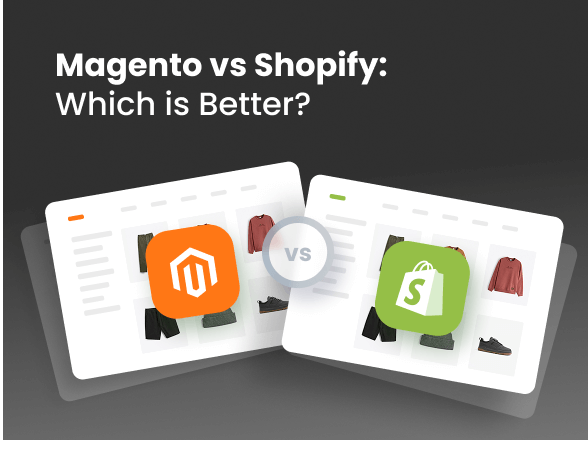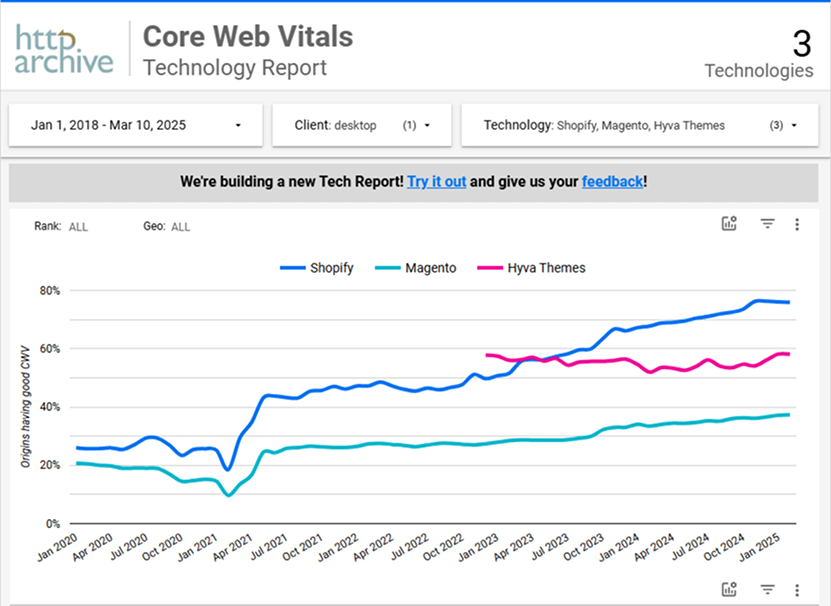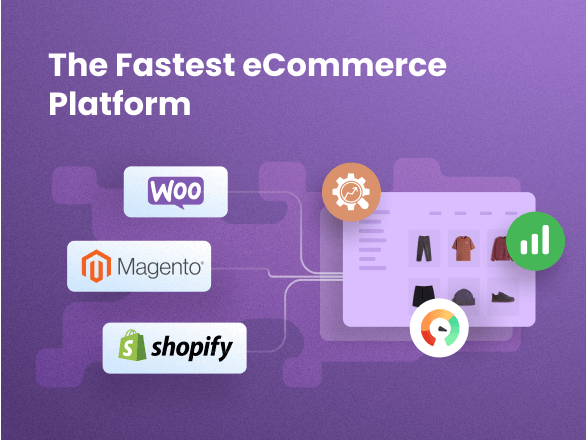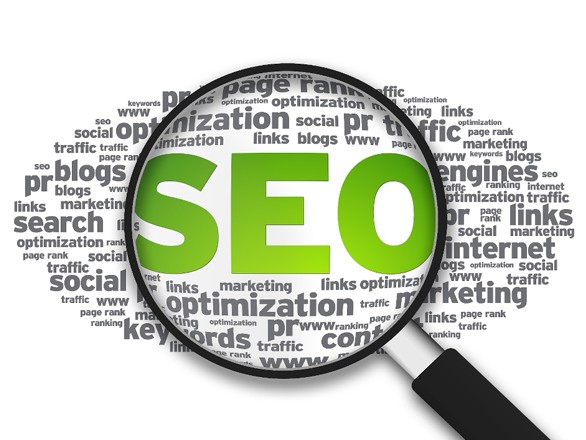Magento vs Shopify: Which is Better?
Magento and Shopify are quite different in their nature: one allows full control over code while the other provides an opportunity to create a website without coding skills. However, sometimes, ease of use doesn’t equal success and effectiveness. To build a thriving online store, you should consider a number of facts and compare different features to match your needs and goals.
Interestingly, despite Shopify’s massive user base of over 4.6 million, Magento remains the platform of choice for many enterprises handling high-volume sales and intricate catalogs. This contrast highlights that the ‘best’ platform isn’t universal but depends heavily on individual business needs.
Therefore, this article will break down the essential differences between Magento and Shopify, examining aspects such as ease of use, themes and templates, and pricing. By understanding these key distinctions, you can confidently select the platform that will empower your online business to flourish.
What is Shopify?
Shopify is a SaaS (Software as a Service) platform, which means that it delivers its service on a subscription basis. So, Shopify takes on technical complexities, allowing you to focus on building the website and growing your business.
The platform is renowned for its user-friendliness and intuitive design. Creating an online store with Shopify is a piece of cake because it offers 80+ themes, a drag-and-drop builder, unlimited products, and a built-in mobile shopping cart. That makes the process quite simple and streamlined, even for those unfamiliar with coding.
Customizing Shopify stores is easy due to robust API and Liquid templating language, which fosters customization and integration. Also, the platform provides the Shopify App Store, where you can find a lot of apps for improving the website.
What is Magento?
Magento is an open-source ecommerce platform that ensures complete control over the backend, making it extremely customizable.
The platform has a range of features that help to handle the complexities of modern ecommerce stores. The core features include a user-friendly backend CMS for content management, a sophisticated shopping cart and checkout system, seamless integration with numerous payment gateways, and powerful tools for managing orders and inventory. Due to this feature set, Magento remains the ultimate solution for running multiple stores, managing workloads, and handling high volumes of products.
Key Differences Between Magento and Shopify
Magento vs Shopify: Ease of Use
| | |
Shopify stands out for its exceptional ease of use, designed to welcome newcomers to ecommerce. The platform offers an intuitive interface coupled with a streamlined onboarding process, guiding users through store setup with a clear step-by-step approach. Its clean, unified dashboard centralizes essential tools, minimizing navigation and allowing users to quickly focus on crucial business aspects. This user-friendliness extends to theme selection and customization. Shopify's curated theme store provides aesthetically pleasing, user-friendly themes easily adaptable via an integrated theme editor featuring drag-and-drop functionality. These themes are perfect for quickly launching visually appealing stores without requiring any coding expertise, making design accessible to everyone. | Magento offers a different experience, with a harder learning curve because it's open-source and has a complex structure. Navigating Magento effectively demands a higher degree of technical understanding, often necessitating the involvement of developers or agencies for initial setup and in-depth customization. However, this complexity unlocks powerful, highly customizable features and functionalities that surpass Shopify's capabilities. Magento's theme environment mirrors this ethos, offering a vast marketplace with themes geared towards extensive customization and broad functionality. While providing unparalleled design flexibility to brands with specific visions, achieving tailored and unique aesthetics often requires development expertise, contrasting with Shopify's simpler, more readily accessible theme approach. |
Magento vs Shopify: Pricing
| | |
Shopify employs a predictable subscription model, simplifying budgeting with inclusive hosting and security. Shopify offers tiered plans:
However, costs can increase with transaction volume and desired features. Specifically, using payment gateways other than Shopify Payments incurs transaction fees (0.6% - 2%). Furthermore, themes and apps to expand functionality are purchased separately. While accessible initially, Shopify's total cost can scale with business growth and customization needs. | Magento offers a contrasting pricing structure. The Open Source (Community) edition is free to download, eliminating subscription fees. This shifts costs to the user, who becomes responsible for web hosting, security, and domain registration, leading to potentially variable expenses. For larger businesses, Magento offers enterprise solutions:
These include support and full features but represent a significant investment. While initial Magento setup can be pricier due to infrastructure and development, it avoids platform transaction fees and can be cost-effective at scale, particularly for those utilizing the free open-source edition and managing their own infrastructure. |
Magento vs Shopify: Seo & Marketing Features
| | |
When considering Magento vs Shopify for SEO and Marketing, Shopify emphasizes user-friendliness and ease of implementation. For SEO, Shopify automatically handles key aspects like sitemaps and SEO-friendly URLs, and offers basic built-in editing for titles and meta descriptions. While its native SEO is simpler compared to Magento, Shopify compensates with a vast app store. This ecosystem provides numerous SEO apps for more advanced needs, offering flexibility but potentially less direct control than native features. In terms of marketing, Shopify includes basic built-in tools like email marketing and social media integration. The extensive Shopify App Store is again key, offering a wide array of marketing applications for everything from email campaigns to social media management, all easily integrated for users of varying technical skills. | Magento distinguishes itself with robust, built-in SEO and marketing capabilities, which are especially beneficial for complex stores. Magento SEO offers granular control over URLs, meta data, and schema markup natively, supporting advanced strategies without relying heavily on extensions. Its architecture inherently supports SEO best practices, making it a strong choice for competitive markets demanding highly customized SEO. For marketing, Magento’s core platform boasts powerful built-in features like advanced catalog management, customer segmentation, and sophisticated promotion tools. While extensions are available, Magento’s inherent marketing functionalities are significantly deeper than Shopify’s base offering, making it well-suited for businesses requiring complex, large-scale marketing strategies right out of the box. |
Magento vs Shopify: Speed & Performance
| | |
In the Magento vs Shopify speed comparison, Shopify generally offers excellent out-of-the-box speed and performance. As a fully hosted platform, Shopify handles server optimization and infrastructure, ensuring fast loading times for most stores without requiring user technical intervention. This ease of use regarding speed is a significant advantage, especially for businesses prioritizing quick setup and a smooth user experience with minimal technical overhead. | Magento's performance is significantly dependent on user management, especially regarding speed. Being self-hosted, Magento's speed is heavily influenced by the chosen hosting environment, server configuration, and implemented optimizations. Magento's default frontend theme, Luma, while feature-rich, can be resource-intensive and contribute to slower page load times if not properly optimized. However, Magento can achieve very fast loading times with proper setup and optimization, particularly when leveraging modern, performance-focused themes like Hyva. Hyva Themes offer a dramatically lighter frontend, designed to drastically improve Magento 2 speed. Despite these advancements, realizing optimal speed with Magento still often requires technical expertise and ongoing attention to server performance. Without careful management and potentially utilizing solutions, Magento sites can be slower than Shopify counterparts. |
The Core Web Vitals report visually summarizes Magento and Shopify speed discussion, showcasing the percentage of origins having good CWV over time for Shopify, Magento, and Hyva Themes. Shopify consistently leads in origins with good CWV, reflecting its ease of speed optimization. Magento, while starting with a lower percentage, demonstrates the significant impact of Hyva Themes, which rapidly improves Magento’s Core Web Vitals performance. The theme helps in reaching levels comparable to Shopify and showcasing its potential to bridge the speed gap.
Magento vs Shopify: Shipping & Payment
| | |
Shopify streamlines shipping and inventory management with intuitive, built-in features ideal for small to medium-sized businesses. It offers user-friendly inventory tools, including bulk import/export, and efficient automated order fulfillment processes. For payments, Shopify supports a broad spectrum of over 100 gateways globally, ensuring wide customer payment option compatibility. Their native Shopify Payments eliminates transaction fees, though it's geographically limited. However, choosing external gateways will incur Shopify transaction fees, in addition to standard payment processing fees, which should be factored into cost considerations. | Magento delivers advanced capabilities in shipping, inventory, and payment, catering to larger and more complex operations. Its inventory management provides granular control, multi-warehouse support, and customizable workflows. Order processing is also highly customizable, allowing tailored setups. In payments, Magento’s open-source nature grants ultimate flexibility, supporting any payment gateway without platform-imposed restrictions. While Magento avoids Shopify's transaction fees, users must directly manage payment gateway integration and processing fees. This flexibility and control come with a potentially steeper technical learning curve for gateway configuration compared to Shopify's simpler, more integrated approach. |
Magento vs Shopify: Customization
| | |
Shopify emphasizes ease and speed, offering customization primarily through professionally designed themes. Users can adjust themes and make some code modifications, mainly focusing on visual aspects within Shopify's structure. This theme-driven approach allows for quick store setup and design adjustments, ideal for businesses prioritizing simplicity and rapid deployment over deep, code-level alterations. | Magento's open-source nature grants unparalleled customization. Full code access allows developers to deeply modify both storefront and backend, creating highly tailored and bespoke solutions. This adaptability is perfect for businesses with unique or complex needs requiring maximum control and extensive feature customization beyond standard templates. |
Magento vs Shopify: Plugins and Apps
| | |
Shopify's user-friendly App Store is a major advantage. Boasting thousands of apps (over 8000+ free and paid apps), it covers diverse functionalities from marketing to inventory. Apps are easily installed and configured, often without needing technical skills. This ease of use comes with potential costs, as app expenses can accumulate, and reliance on third-party apps for core features is common. | In the Magento vs Shopify comparison, Magento utilizes a broader ecosystem of extensions, not a centralized app store like Shopify. These Magento extensions, from marketplaces and agencies, offer powerful, tailored integrations and deep customization of core functionalities. While enabling bespoke ecommerce experiences, accessing this power typically demands hiring Magento experts for installation, configuration, and potential customization by developers. |
Magento VS Shopify: Comparison Summary
The choice between Shopify or Magento boils down to a fundamental trade-off: simplicity and speed versus power and customization.
| Features | | |
| Ease of Use | Very Easy. Beginner-friendly. Intuitive setup. | Complex. Steeper learning curve. Dev help often required. |
| Themes | Curated & Easy. Visually appealing, drag-and-drop. | Flexible & Custom. Highly customizable, but often needs dev. |
| Pricing | Subscriptions: Monthly fees (Basic $39, etc.). Costs scale with usage/features. Transaction fees may apply. | Open Source: Free core, but hosting/dev costs. Enterprise versions expensive (Commerce: Open Dource: Free; Commerce: $22K+; Commerce Cloud: $60K+). No transaction fees. |
| SEO | User-Friendly. Basic built-in, app store for more. | Powerful. Granular control, advanced built-in. |
| Marketing | Basic Built-in + App Store. Easy app expansion. | Advanced Built-in. Sophisticated features out-of-box. |
| Speed & Performance | Excellent out-of-the-box, fully hosted. | Dependent on Management. Self-hosted, optimization needed. Hyva themes improve speed. |
| Shipping & Inventory | Simple Mgmt. Intuitive, for SMBs. | Advanced Mgmt. Multi-warehouse, custom control. |
| Payment Gateways | Wide Choice. 100+ gateways. Fees may apply. | Any Gateway. Open-source flexibility. No platform fees. |
| Customization | Theme-Driven. Visual, limited code access. | Code-Level. Fully customizable backend & frontend. |
| Plugins/Apps | Large, Easy App Store. Can get costly. | Customizable Extensions. Deep integrations, often need dev. |

Still Can’t Decide Between Magento and Shopify?
If you’re feeling torn between Magento or Shopify, we’re here to help! Our experts can provide you with personalized insights to ensure you make the best decision based on your unique business needs.
Choose Shopify when:
Shopify remains the optimal choice when your priority is a rapid and uncomplicated path to launching and managing an online store. It’s the ideal platform for businesses that value:
- Instant Launch & Intuitive Operation: Shopify’s straightforward setup, user-friendly interface, and drag-and-drop theme customization allow for incredibly fast store creation and easy daily management, even without technical expertise.
- Budget-Friendly Predictability: Shopify’s subscription model offers predictable monthly expenses, bundling hosting and security. While app and transaction fees exist, the base cost structure is transparent and aids financial planning.
- Streamlined Simplicity for Core Features: Shopify provides robust, user-friendly features for inventory, shipping, and payments, alongside a vast app store for easily extending functionality as needed, all while maintaining user-friendliness.
- Fast Performance Out-of-the-Box: Shopify’s hosted platform delivers excellent speed performance from the start, requiring little user optimization for most businesses.
In short, choose Shopify for its unparalleled ease of use, speed of deployment, and streamlined management. It’s the perfect platform for startups, SMBs, and anyone prioritizing simplicity and speed to market.
Choose Magento When:
Magento is the definitive platform for businesses that demand unmatched control, deep customization, and robust features to build a strategically powerful and scalable online presence. It’s the solution for those who require:
- Limitless Customization & Bespoke Experiences: Magento’s open-source architecture provides unparalleled customization, allowing for fully unique designs, tailored functionalities, and deep integrations, adaptable to highly specific business needs.
- Advanced, Built-in Feature Depth: Magento excels with robust built-in SEO, advanced marketing tools, and granular inventory management, reducing reliance on third-party extensions for complex operations.
- Scalability for Enterprise-Level Growth: Magento is engineered for enterprise-grade scalability, capable of handling massive product catalogs, intricate workflows, and high traffic volumes, making it future-proof for ambitious businesses.
- Flexible, Fee-Free Platform at Scale: Magento’s open-source edition eliminates subscription fees, and while initial setup and hosting can be more complex, it can become highly cost-effective as your business grows, especially for technically proficient teams.
Essentially, choose Magento when deep customization, comprehensive control, and advanced, scalable features are paramount, and you have the resources to leverage its powerful capabilities. It’s the strategic asset for established businesses, complex operations, and those viewing e-commerce as a core competitive differentiator.

Ready to Start Your Ecommerce Path?
Developing a website is a complex and crucial process that requires expert guidance. At Plumrocket, we specialize in building high-performance ecommerce stores tailored to your business needs. Let our experienced team handle the development while you focus on growing your business.
🏆 17+ Years in Business | 🔹 Trusted by 150,000+ businesses | ⭐ 1000+ Positive Reviews
Conclusion
Choosing Magento or Shopify involves balancing your business needs with each platform’s offerings. Magento is suited for businesses wanting high customizability, while Shopify provides simplicity and ease of use. Both platforms empower businesses to create compelling online stores, but their strengths cater to different scales and types of operations. Careful consideration of your technical expertise, budget, and future growth is essential in making the right choice. Ultimately, aligning your choice with your business strategy will lead to better outcomes and a successful ecommerce journey.





